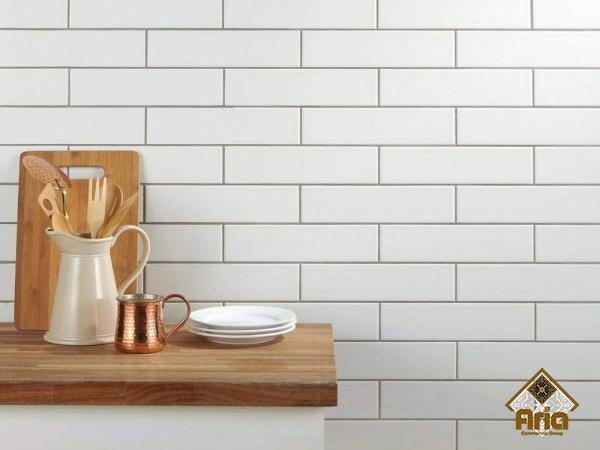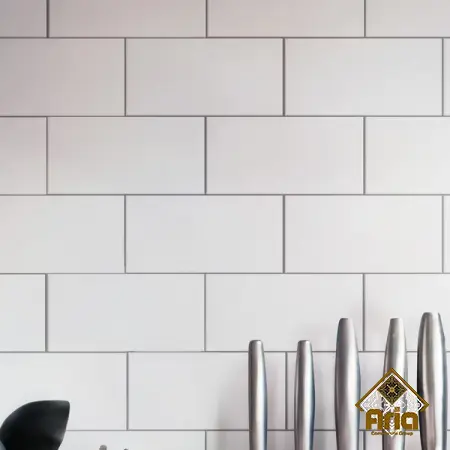Ceramics are generally divided into the following four Ceramic subway tile producercategories: Special and technical ceramic products (such as anti-acid ceramics and tiles) Refractory ceramics Rough ceramic products Delicate ceramic products The most widely used ceramic products are divided into the following categories. Ceramic household utensils Building sanitary ceramics Tiles Electrical insulation and insulators Machines used to produce ceramics and tiles In ceramic tile factories, they use advanced tools related to each stage to produce their products; These devices are used in the order of making ceramic: “Crusher, box feeder, grinder and glaze, spray dryer, press machine, roller and tunnel furnaces, glaze and decor line, packing and grading machines” In the following, we will explain the steps of producing ceramic tiles to you and introduce you to this process.
Stage 1: Preparation of the raw materials needed to make tile and ceramic tiles of the tiles are usually taken from different soils that are taken in different conditions and from different mines. These tiles and their ceramic are based on the use and role they have made of different raw materials, including plastic raw materials, fillers or fillers, and melting, or glossary. The initial cases of plastic is the same as the clay plasticity of the clay that is defined as the following: the property of the plasticity of the property, which by which a body can have a resident and impact of the elasticity and without breaking, and after the pressure of the pressure or the bump, it will return to the first time. One of the characteristics of the clay is a plasticity. Fillers or filters are said to be non-plastic materials that have high melting temperatures and high chemical resistance, and their duty is to prevent the body’s deformation at the time of baking and heating. It also helps to link a better quality glaze with a ceramic self-administered. The gadgets are substances that have high

Categories types of ceramic subway tile based on production line
 Step 1: Operating surface rating by operators At this stage, the work of grading the ceramic tiles with the appearance surface is done by the operators. In the surface grading section, operators magically determine the grade on the tile. At this stage, the operators grade the tiles based on the defects in the tile, such as glaze, cracks, welds, print quality, color, paleness, etc. Tiles are generally graded based on appearance, arch and size.Step 2: Arc (Blancher) After the apparent surface part of the tile, it reaches the arc (blanner). In this section, 5 sensors are located next to each other, each sensor has two electronic eyes. The sensors classify the tile based on the arc based on the information given to the machine. Convex tiles: If the tile…. Has 0.8% error (Grade 1) Has an error of 0.1% (Grade 2) 1.3% error (Grade 3) Concave tiles: If the tile… Has an error of 0.5% (Grade 1) 0.7% error (Grade 2) Has 0.9% error (Grade 3) Step 3: Calibrate the part (sizer) After passing the tiles from this part, it reaches the calibrator (sizer) where the tiles are graded in terms of size. In the ceramic tile grading section, all the tiles on this line pass through sensors that measure the tiles and compare them to the sample tile (a tile of normal size). After this part, the tiles reach two infrared sensors that.Step 6: Transfer the separated tiles to the carton In this part, the tiles are arranged in a row by several arms. The cartons are then fed into the input device by air suction and placed around the tiles. After leaving this part, the tile box reaches the device (printer). The task of this device is to engrave the code, grade and date of production on the box. After the printer, the tile is covered with a layer of plastic and the box goes inside the machine (shearing). This device uses the heat in it to harden the plastic around the box and stick it on it.
Step 1: Operating surface rating by operators At this stage, the work of grading the ceramic tiles with the appearance surface is done by the operators. In the surface grading section, operators magically determine the grade on the tile. At this stage, the operators grade the tiles based on the defects in the tile, such as glaze, cracks, welds, print quality, color, paleness, etc. Tiles are generally graded based on appearance, arch and size.Step 2: Arc (Blancher) After the apparent surface part of the tile, it reaches the arc (blanner). In this section, 5 sensors are located next to each other, each sensor has two electronic eyes. The sensors classify the tile based on the arc based on the information given to the machine. Convex tiles: If the tile…. Has 0.8% error (Grade 1) Has an error of 0.1% (Grade 2) 1.3% error (Grade 3) Concave tiles: If the tile… Has an error of 0.5% (Grade 1) 0.7% error (Grade 2) Has 0.9% error (Grade 3) Step 3: Calibrate the part (sizer) After passing the tiles from this part, it reaches the calibrator (sizer) where the tiles are graded in terms of size. In the ceramic tile grading section, all the tiles on this line pass through sensors that measure the tiles and compare them to the sample tile (a tile of normal size). After this part, the tiles reach two infrared sensors that.Step 6: Transfer the separated tiles to the carton In this part, the tiles are arranged in a row by several arms. The cartons are then fed into the input device by air suction and placed around the tiles. After leaving this part, the tile box reaches the device (printer). The task of this device is to engrave the code, grade and date of production on the box. After the printer, the tile is covered with a layer of plastic and the box goes inside the machine (shearing). This device uses the heat in it to harden the plastic around the box and stick it on it.
Hot Price Offer on Ceramic subway tile from main producer
 The twenty-seventh Coverings, the pre-eminent North American exhibition for the tile and stone industry, closed its doors on 21 April in Chicago. The exhibition was strongly attended and hosted 1,220 exhibitors from more than 40 countries. Several country pavilions were set up in addition to the US exhibit organised by the Tile Council of America (TCNA). The large Italian pavilion (122 companies and brands) organised by Confindustria Ceramica under the banner of Ceramics of Italy showcased hundreds of innovative products including high-end mosaics, porcelain tiles, large-format porcelain panels, antibacterial grout and simple installation systems. One of the key events was the presentation of the 26th Confindustria Ceramica North American Distributor Award, assigned to the distributor that has excelled the most in its dealings with Italian ceramic industry. This year’s winner, the company Ceramic Technics (Alpharetta, GA), stood out for its relationship with leading architecture and design firms, collaborating in particular on projects in the hospitality, healthcare and educational sectors. Spanish ceramic excellence took centre stage in a country pavilion organised by ASCER and hosting 68 companies under the banner of Tile of Spain. The Spanish pavilion showcased a wide range of cutting-edge products and hosted a variety of initiatives. In particular, two seminars led by Ryan Fasan entitled “From Skin to System: Rethinking Ceramic’s Place in Design” and “User Experience Focus: Trends in Ceramics 2016” offered industry professionals some useful insights into innovation, large sizes and major trends in ceramics in keeping with UX design principles. Coverings 2017 will be held in the Orange County Convention Center in Orlando from 4 to 7 April next year 120,000dolar
The twenty-seventh Coverings, the pre-eminent North American exhibition for the tile and stone industry, closed its doors on 21 April in Chicago. The exhibition was strongly attended and hosted 1,220 exhibitors from more than 40 countries. Several country pavilions were set up in addition to the US exhibit organised by the Tile Council of America (TCNA). The large Italian pavilion (122 companies and brands) organised by Confindustria Ceramica under the banner of Ceramics of Italy showcased hundreds of innovative products including high-end mosaics, porcelain tiles, large-format porcelain panels, antibacterial grout and simple installation systems. One of the key events was the presentation of the 26th Confindustria Ceramica North American Distributor Award, assigned to the distributor that has excelled the most in its dealings with Italian ceramic industry. This year’s winner, the company Ceramic Technics (Alpharetta, GA), stood out for its relationship with leading architecture and design firms, collaborating in particular on projects in the hospitality, healthcare and educational sectors. Spanish ceramic excellence took centre stage in a country pavilion organised by ASCER and hosting 68 companies under the banner of Tile of Spain. The Spanish pavilion showcased a wide range of cutting-edge products and hosted a variety of initiatives. In particular, two seminars led by Ryan Fasan entitled “From Skin to System: Rethinking Ceramic’s Place in Design” and “User Experience Focus: Trends in Ceramics 2016” offered industry professionals some useful insights into innovation, large sizes and major trends in ceramics in keeping with UX design principles. Coverings 2017 will be held in the Orange County Convention Center in Orlando from 4 to 7 April next year 120,000dolar











Your comment submitted.